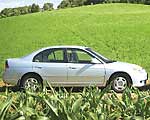|
Alternative Energy Bulletin
|
|||||||||||||||||||||||||||||||||||||
|
Hybrid and Electric Cars
Background The development of hybrid cars traces back in large part to a 1990 decision by the California Air Resources Board mandating that by 1998, two percent of all new cars sold in California were to have zero emissions. In 1993, the Clinton administration followed California's lead with its Partnership for a New Generation of Vehicles (PNGV). PNGV required the auto industry to develop a car with up to triple the fuel efficiency of the average midsize car. In return, the U.S. auto industry would receive federal funding, and access to federal agency and laboratory research. Over the next seven years, $1.25 billion of federal funds would go into the PNGV program. This led to advances in electric drive-train components and battery storage. By 1996, General Motors was ready to release its first electric car, the EV1. Meanwhile Japanese automakers, who had been excluded from PNVG, did not want to be shut out of an emerging market. The Japanese, however, would focus their efforts on developing a fuel efficient vehicle that could run on both gasoline and electricity (a hybrid vehicle). The hybrid car was seen as having two distinct advantages over the electric car: 1) the distance a hybrid could travel before refueling would be greater, and 2) a hybrid car would not require the time consuming task of having to be plugged into an electrical outlet. In 1999, Honda released the two-door Insight, the first hybrid car to hit the mass market in the United States. The Insight won numerous awards, and received EPA mileage ratings of 61 mpg city and 70 mpg highway. In 2000, Toyota released the Toyota Prius, the first hybrid four-door sedan available in the United States. Soon American auto companies would produce their own hybrid models. Recently, there is increasing interest in what is called a plug-in hybrid. A plug-in hybrid is like a regular hybrid, but with larger batteries and the ability to re-charge from a standard electrical outlet. It's the best of both worlds: With a plug-in hybrid, local (short range) travel is electric, but there is always a gas tank backup for longer trips.
|
|
|||||||||||||||||||||||||||||||||||
|
|
|||||||||||||||||||||||||||||||||||||






